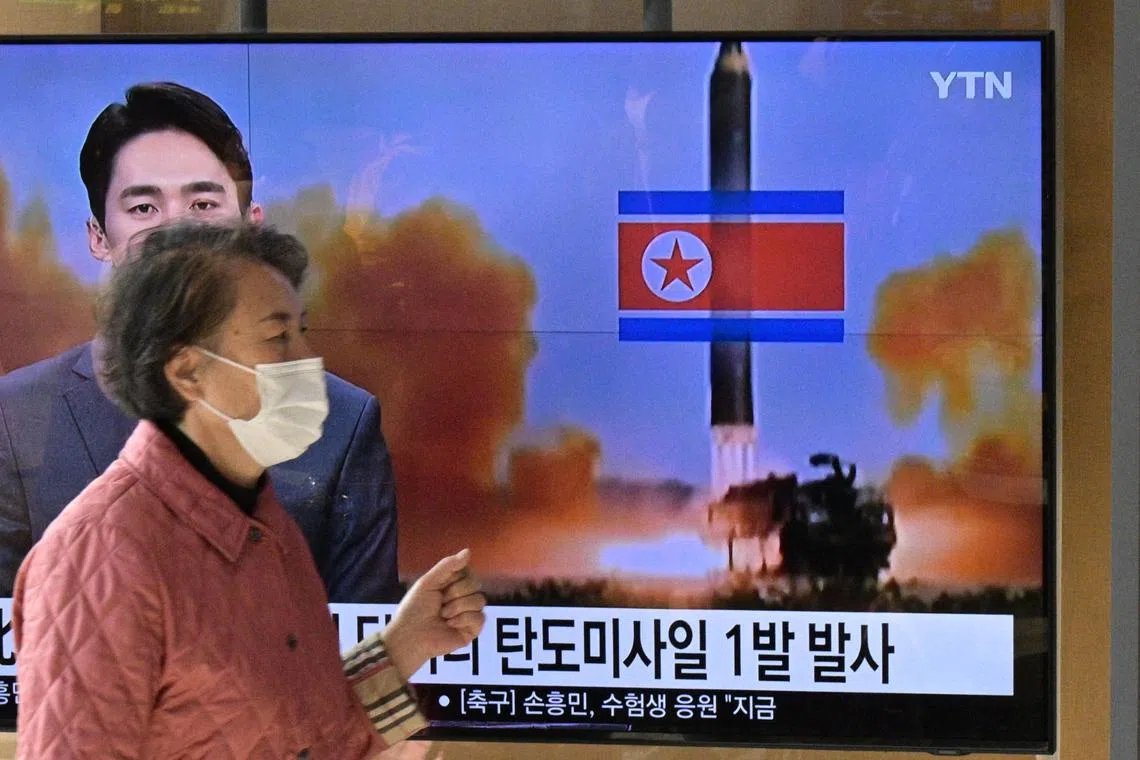North Korea continues record-breaking blitz, fires another ballistic missile
Sign up now: Get insights on Asia's fast-moving developments

A news broadcast with showing a file photo of a North Korean missile test, at a railway station in Seoul on Nov 17, 2022.
PHOTO: AFP
Follow topic:
SEOUL – North Korea fired a suspected intercontinental ballistic missile (ICBM) on Friday that landed just 200km off Japan and had sufficient range to reach the mainland of the United States, Japanese officials told reporters.
The launch, reported by both South Korean and Japanese officials, comes a day after a smaller missile launch by the North
It was concerning enough that United States Vice-President Kamala Harris, who is in Bangkok for a regional summit, scheduled urgent talks about the incident with leaders from Japan, South Korea, Australia, New Zealand and Canada.
This has become a record-breaking year for the nuclear-armed country’s missile programme, after it resumed testing ICBMs for the first time since 2017 and broke its self-imposed moratorium on long-range launches as denuclearisation talks stalled.
Japanese Defence Minister Yasukazu Hamada told reporters the latest missile was capable of flying as far as 15,000km, while Chief Cabinet Secretary Hirokazu Matsuno said it flew to an altitude of about 6,000km with a range of 1,000km, before landing in the sea roughly 200km west of Oshima-Oshima Island in Hokkaido.
North Korea often conducts its tests on such “lofted” trajectories where the missile flies much higher into space but to a shorter distance than it would if fired on a normal trajectory.
Japanese Prime Minister Fumio Kishida said there had been no reports of damage but the North’s repeated missile launches could not be tolerated.
“The ballistic missile launched by North Korea is believed to have landed in our EEZ (exclusive economic zone), west of Hokkaido,” he told reporters in Bangkok, where he is attending a regional summit.
Misawa Air base, which hosts both Japanese and US troops, briefly issued an order to seek cover, according to a post on the base’s Facebook page.
South Korean President Yoon Suk-yeol condemned the launch and said he would work with the international community for a coordinated response to the North’s repeated missile launches.
The US said it strongly condemns the latest launch.
National Security Council spokesman Adrienne Watson said: “The president has been briefed on the situation and he and his national security team will continue close consultations with allies and partners.
“This launch is a brazen violation of multiple UN Security Council resolutions and needlessly raises tensions and risks destabilising the security situation in the region.”
Going ballistic
North Korea’s last suspected ICBM test was on Nov 3, when it fired multiple missiles into the sea
Friday’s launch would be the eighth ICBM test this year by North Korea, based on a tally from the US State Department.
ICBMs are North Korea’s longest-range weapon and are designed to carry a nuclear warhead as far as any location in the continental US.
On Thursday, North Korea fired a short-range ballistic missile while its Foreign Minister Choe Son Hui warned of “fiercer military responses” to US moves to boost its military presence, saying Washington was taking a “gamble it will regret”.
In a statement carried by state media, Ms Choe condemned a Sunday trilateral summit of the US, South Korea and Japan during which those countries’ leaders criticised Pyongyang’s weapons tests and pledged greater security cooperation.
“Pyongyang is trying to disrupt international cooperation against it by escalating military tensions and suggesting it has the capability of holding American cities at risk of nuclear attack,” said Professor Leif-Eric Easley at Ewha University in Seoul.

Hwasong-17 ICBMs being displayed during a military parade in Pyongyang on April 25, 2022. The missiles are North Korea’s longest-range weapon.
PHOTO: AFP
This year, North Korea has conducted a record number of ballistic missile tests, which are banned by United Nations Security Council resolutions that have sanctioned the country over its missile and nuclear weapons programmes.
ICBMs are ballistic missiles with a minimum range of about 5,500km, chiefly designed for nuclear weapons delivery. Some are capable of travelling 10,000km or more.
Some missiles carry only one warhead but analysts suspect that North Korea is seeking to develop ICBMs that can carry multiple warheads, each able to navigate to a separate aimpoint, on independently targetable re-entry vehicles (MIRVs).
Failure to launch
Based on photos released by state media, analysts said the Nov 3 launch appeared to be a previously unseen ICBM, possibly a variant of the Hwasong-15 ICBM, which was first tested in 2017 and may have been launched in March as well.
A South Korean official said the Nov 3 test may have failed at high altitude. South Korean and US officials have reported that a number of North Korean ICBM tests appeared to have failed this year.
North Korea claimed to have successfully launched its massive new Hwasong-17 ICBM for the first time on March 24, but South Korean and US officials concluded that launch appears to have been the previously launched Hwasong-15.
The March 24 launch was nevertheless the biggest ICBM test ever staged by the North, flying 67.5 minutes to a maximum altitude of 6,248.5km, North Korean state media reported.
The North has also fired hundreds of artillery shells into the sea recently as South Korea and the US staged exercises, some of which involved Japan. REUTERS, AFP

